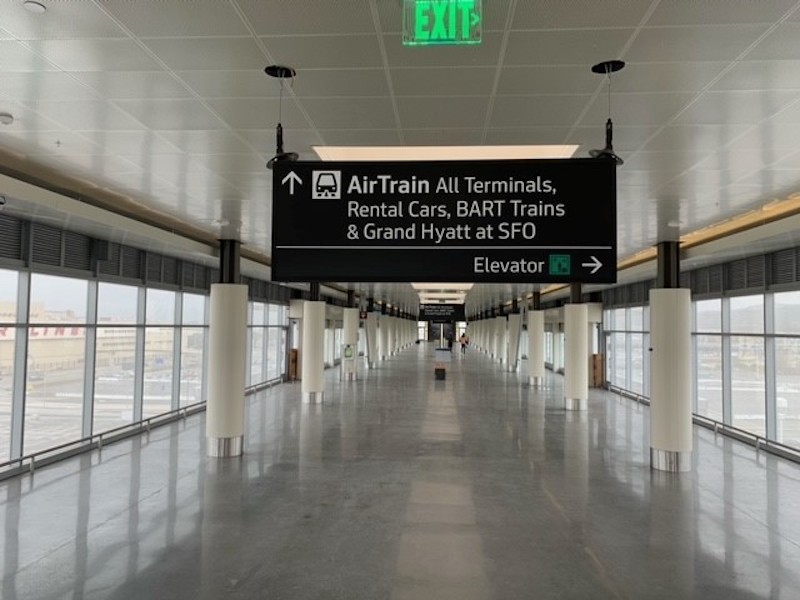In May, the San Francisco International Airport completed the extension of its AirTrain people mover system to its Long-Term Parking area. At that point, the AirTrain provided connectivity between all terminals, parking garages, an on-airport hotel, the city’s subway system, and the airport’s car rental center. Previously transportation between the long-term parking lot and the terminals had been provided by shuttle buses, and AirTrain’s extension is projected to eliminate 600,000 miles of trips annually, according to the airport.
This $259 million project, which launched in August 2016, extends the AirTrain guideways by 1,900 ft to reach the long-term parking lot. The project included the construction of two new AirTrain stations, each of which built under a $172 million progressive design-build contract with Skanska USA and WSP. The first station, located at the on-site Grand Hyatt hotel, opened to the public on October 2, 2019; the second station, with a pedestrian bridge that connects AirTrain to one of two Long-Term Parking multilevel garages, opened on May 5 of this year.
VERY GREEN STOPS
The construction project’s highlights include the installation of a 2,700-panel PV array on the roof of the long-term parking garage that will generate about two-fifths of the stations’ annual power needs. Water-efficient fittings and fixtures will cut the stations’ water use by 40%. Three-quarters of this project’s construction and demolition debris were recycled. The stations’ indoor air quality complies with LEED air quality assessment standards (prior to occupancy).
In total, more the 50 sustainable practices were implemented as part of the construction of the stations, which were certified LEED Gold in September. “Achieving LEED Gold certifications demonstrates our commitment to employing sustainable practices on every project we undertake,” said Tony Taddeo, Senior Vice President of Operations for Skanska USA Civil.

PGH Wong was its construction manager on the AirTrain extension project.
AirTrain, which has been in operation since 2003, currently consists of 41 electric vehicles that run along six miles of fully automated concrete guideways.
Related Stories
| Mar 26, 2014
Callison launches sustainable design tool with 84 proven strategies
Hybrid ventilation, nighttime cooling, and fuel cell technology are among the dozens of sustainable design techniques profiled by Callison on its new website, Matrix.Callison.com.
| Mar 20, 2014
Common EIFS failures, and how to prevent them
Poor workmanship, impact damage, building movement, and incompatible or unsound substrate are among the major culprits of EIFS problems.
| Mar 12, 2014
14 new ideas for doors and door hardware
From a high-tech classroom lockdown system to an impact-resistant wide-stile door line, BD+C editors present a collection of door and door hardware innovations.
| Feb 14, 2014
Crowdsourced Placemaking: How people will help shape architecture
The rise of mobile devices and social media, coupled with the use of advanced survey tools and interactive mapping apps, has created a powerful conduit through which Building Teams can capture real-time data on the public. For the first time, the masses can have a real say in how the built environment around them is formed—that is, if Building Teams are willing to listen.
| Feb 10, 2014
Proposed parking garage will sandwich vehicles between housing and retail space
Architecture firm Brisac Gonzalez says that the design "will introduce different activities after parking hours."
| Jan 28, 2014
16 awe-inspiring interior designs from around the world [slideshow]
The International Interior Design Association released the winners of its 4th Annual Global Excellence Awards. Here's a recap of the winning projects.
| Jan 13, 2014
Custom exterior fabricator A. Zahner unveils free façade design software for architects
The web-based tool uses the company's factory floor like "a massive rapid prototype machine,” allowing designers to manipulate designs on the fly based on cost and other factors, according to CEO/President Bill Zahner.
| Jan 11, 2014
Getting to net-zero energy with brick masonry construction [AIA course]
When targeting net-zero energy performance, AEC professionals are advised to tackle energy demand first. This AIA course covers brick masonry's role in reducing energy consumption in buildings.
Smart Buildings | Jan 7, 2014
9 mega redevelopments poised to transform the urban landscape
Slowed by the recession—and often by protracted negotiations—some big redevelopment plans are now moving ahead. Here’s a sampling of nine major mixed-use projects throughout the country.
| Jan 6, 2014
What is value engineering?
If you had to define value engineering in a single word, you might boil it down to "efficiency." That would be one word, but it wouldn’t be accurate.

















